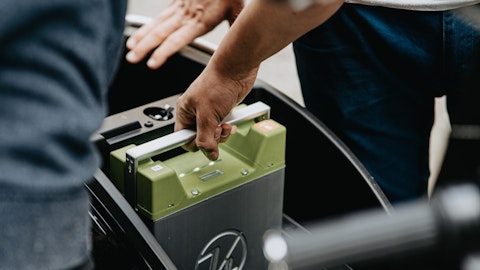It’s been a lot of activity in Quebec, there just aren’t many spodumene projects in the US and people are principally – the mining folks are principally focused on spodumene just from a risk management perspective and ease of getting into production. Piedmont’s been an acquirer. Meaning, we obviously were quite fortunate to make well-timed investments in the Sayona and Atlantic Lithium and their projects. We’ve looked at – we’ve been approached with literally over 100 other opportunities in the interim, the only one we’ve invested in was the Killick Project up in Newfoundland we announced last month, very modest upfront capital investment which we think big upside. I think as we derisk our story, and I think this is an industry that’s probably in the second or third inning of its evolution, and stories like Piedmont advance and become derisked and projects receive permits, receive funding are being built and kind of come into production.
I think you’ll certainly see significant consolidation in the industry and we may or may not be a part of that down the road.
Matthew Key: Got it. Thanks for that color, Keith. And best of luck moving forward.
Keith Phillips: Thanks.
Operator: We will take our next question from Eric Boyes with Evercore ISI. Your line is open.
Eric Boyes: Good morning. Thanks. Two questions. First, back on the clarification that now price realization occurs at the time of delivery, not shipment. So, what is the typical timeline from – shipment from now to delivery to a customer by a trading company? And then, given that timing, is it possible we occasionally see a shipment in a given quarter that isn’t kind of realized until the following quarter?
Keith Phillips: Yeah, great question. So in the third quarter, the joint venture had a shipment through a trading company. Piedmont had two shipments. And interestingly, they each went three separate ways as you look at the globe, one of them went around the coast of Africa, because the Panama Canal was clogged, one went through the Panama Canal, our most recent shipment went through the Northwest Passage. And so it was really – that was fascinating to me that the latter shipment got there in 18 to 20 days, the initial shipment from the JV took 60 or 70 days, if we’re not mistaken. So, it varies. And just to clarify, I should have spoken more precisely earlier. It’s not stated – it’s not written in stone that the price has to be at delivery date, the price could be on one of the shipments we had, the price was very close to delivery date.
In another, the price was actually set with reference to delivery date, but a couple weeks prior. So if delivery date was September 30th, the pricing might be set at September 15th retroactively. And another, it’s at the opposite way kind of forward. So this is a negotiation you have with the customers through the – in our case, through the trading companies we’re working with. And there are always several buyers for any shipment, which is helpful. And you make the decision you make and you hope it works out in the end, but you really don’t know until the final price is paid.
Eric Boyes: Okay, understood. Thanks. And then my second question would be kind of given the price volatility that we’ve seen in – more specifically in the differential between hydroxide and spodumene. Is there any thought in linking Piedmont’s offtake price at Ewoyaa to hydroxide to preclude some of that differential risk as it pertains to Tennessee? Thanks.
Keith Phillips: Yeah, it’s a great question. On the pricing slide earlier in the deck, the reason we included the three lines Fastmarkets, Platts and SMM for hydroxide and spodumene and there’s a third graph not on that page, for carbonate. The really nine different benchmarks you can contract with a customer for. And in our experience, the customers in China the conversion plants, they want to contract based on the chemical they’re producing. So if they’re producing hydroxide, they run through their math of, if hydroxide price is X, I need Y tons of spodumene and I’ve got VAT of Z percent, et cetera. They go through the math and say, here’s what we can pay and that’s how they calculate it. If they’re a carbonate plant, they use carbonate and our shipments have been based on different things.
So I think in terms of how it affects Tennessee, this has been a very good learning experience for us. Our arrangement with Atlantic Lithium is that, we will pay market prices that’s a pretty generic term as you can tell, we’re very interested in how the market prices be linked to the hydroxide will ultimately produce and both from an economic perspective and also the timing perspective, over time, it should also even out, but that should be something I think Atlantic would be interested in as well. So we’re some time away from – we won’t be in construction in Atlantic for another year or so we won’t be in production for a couple of years but that – that’s a detail will work out. I’d like to see Tennessee Lithium’s spodumene input cost be market prices linked to the hydroxide price will receive a Tennessee Lithium around the time we’d be shipping material.
I think it’s just a very sensible thing and that should work for both parties.
Eric Boyes: Make sense? Thank you.
Operator: And we will take our next question from Chris Kapsch with Loop Capital Markets. Your line is open.
Chris Kapsch: Hey, good morning. So I jumped on a little late owing to a scheduling conflict. So apologies if you touched on some of this already. But it sounds like you alluded to a variety of continued and ongoing strategic discussions with various players in different elements of your business. I’m curious, as you engage with downstream cathode or battery or automotive OEM players and talking about their needs. What are they most – what’s most important to them? Where are they most focused on? Is it regionalization supply chain, security supply? Is it the ability to hit battery grade specs? And also just are those conversations still predominantly focused on hydroxide over carbonate even with a more momentum with LP gaining share at least in over in Asia?
Keith Phillips: Great questions. Listen, I think certainly we’re focused on hydroxide. The people we’re speaking to need hydroxide and some lithium carbonate as well. But, most of the spodumene in the world would go into hydroxide, we certainly think is the right thing for the US market. So we’re hydroxide all the time. I would say, parties – I’d say the principal area focus for people, frankly, is America. I mean, we’re in Tennessee in the southeastern US surrounded by EV plants that are being built, cathode plants are being built in Tennessee, South Carolina and elsewhere. With the backing of the Inflation Reduction Act, everybody, the big Korean battery companies, the big US and foreign OEMs, they all want to be here, they need to be here in scale, there’s just going to be a dearth of lithium hydroxide available domestically.
That’s a problem. Even without the IRA, that’s a problem. But with the IRA and with the benefits of having domestic supply, it’s a big issue. Adding to that, within the IRA, there’s the 45x tax credit, which makes American taxpaying entities that gives a tax benefit to American projects is very substantial, more so than if the project were in Australia or Canada or somewhere else. So, people are very excited about that, except they’re going to invest a lot of money in a big capital project, they want to make sure the economics makes sense. The final thing I’ll say about Tennessee, our experience selling spodumene has been really educational in terms of the importance of Tennessee. If you are spod seller or a spodumene concentrate today, the only buyers in terms of producing side, the only buyers of the Chinese converters, there are no others.




